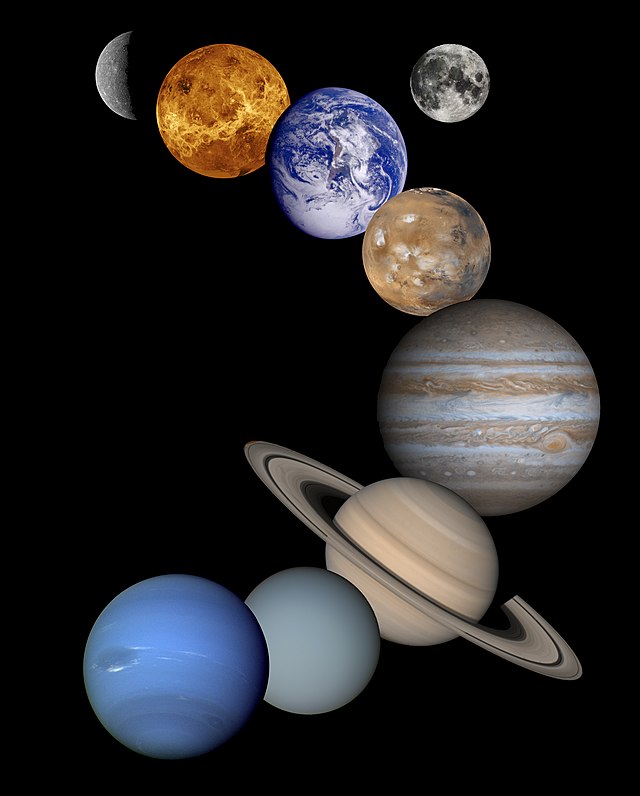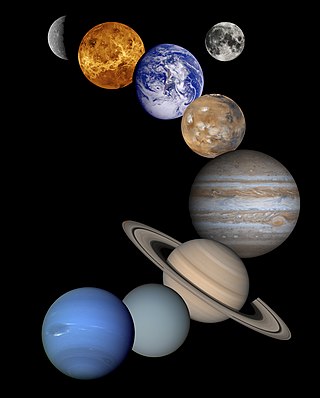List of planet types
Types of planet by chemical mass From Wikipedia, the free encyclopedia
The following is a list of planet types by their mass, orbit, physical and chemical composition, or by another classification.
This article needs additional citations for verification. (February 2020) |

By mass regime
| Planet type | Description | Example(s) |
|---|---|---|
| Super-Jupiter | An astronomical object more massive than the planet Jupiter. | Kappa Andromedae b, Kepler-1625b |
| Giant planet | A massive planet. They are most commonly composed primarily of 'gas' (hydrogen and helium) or 'ices' (volatiles such as water, methane, and ammonia), but may also be composed primarily of rock, which would make one a Mega Earth.[1] Regardless of their bulk compositions, giant planets normally have thick atmospheres of hydrogen and helium. | Jupiter |
| Super-Neptune | A planet that is more massive than the planet Neptune. These planets are generally described as being around 5–7 times as large as Earth with estimated masses of 20–80 ME; | PH1b, K2-33b |
| Neptunian planet | Planets of mass similar to Uranus or Neptune; smaller than the gas giants, but still much larger than Earth. | Gliese 436 b, GJ 3470 b |
| Sub-Neptune | a planet with smaller radius than Neptune even though it may have a larger mass | HD 110067 (b, c, d, e, f and g) |
| Mini-Neptune | Also known as a gas dwarf or transitional planet. A planet up to 10 Earth masses, but less massive than Uranus and Neptune. Mini-Neptunes have thick hydrogen–helium atmospheres, probably with deep layers of ice, rock or liquid oceans (made of water, ammonia, a mixture of both, or heavier volatiles). | HD 63433 c |
| Mega-Earth | Proposed neologism for a massive terrestrial exoplanet that is at least ten times the mass of Earth | Kepler-10c |
| Super-Earth | An extrasolar planet with a mass higher than Earth's, but substantially below the mass of the Solar System's smaller gas giants Uranus and Neptune, which are 14.5 and 17.1 Earth masses respectively. | Kepler-10b, Gliese 667 Cc |
| Sub-Earth | A classification of planets "substantially less massive" than Earth and Venus. | Mercury & Kepler-37b |
By orbital regime
| Planet type | Description | Examples |
|---|---|---|
| Circumbinary planet | An exoplanet that orbits two stars. | PH1b, Kepler-16b |
| Circumtriple planet | An exoplanet that orbits three stars. | Gliese 900 b |
| Double planet | Also known as a binary planet. Two planetary-mass objects orbiting each other. | OGLE-2017-BLG-0380Lb[2] |
| Eccentric Jupiter | A gas giant that orbits its star in an eccentric orbit. | HD 80606 b, HD 20782 b |
| Exoplanet | A planet that does not orbit the Sun, but a different star, a stellar remnant, or a brown dwarf. | Proxima Centauri b, 51 Pegasi b |
| Extragalactic planet | An exoplanet outside the Milky Way. | M51-ULS-1b (unconfirmed) |
| Goldilocks planet | A planet with an orbit that falls within the star's habitable zone. The name derives from the fairy tale "Goldilocks and the Three Bears", in which a little girl chooses from sets of three items, ignoring the ones that are too extreme (large or small, hot or cold, etc.), and settling on the one in the middle, which is "just right". | Kepler-186f, 38 Virginis b |
| Hot Jupiter | A class of extrasolar planets whose characteristics are similar to Jupiter, but that have high surface temperatures because they orbit very close—between approximately 0.015 and 0.5 AU (2.2×106 and 74.8×106 km)—to their parent stars, whereas Jupiter orbits its parent star (the Sun) at 5.2 AU (780×106 km), causing low surface temperatures. | 51 Pegasi b, HD 209458 b, KELT-9b |
| Hot Neptune | An extrasolar planet in an orbit close to its star (normally less than one astronomical unit away), with a mass similar to that of Uranus or Neptune. | Gliese 436 b, LTT 9779 b |
| Inferior planets | Planets whose orbits lie within the orbit of Earth.[nb 1] | Mercury and Venus |
| Inner planet | A planet in the Solar System that have orbits smaller than the asteroid belt.[nb 2] | Mercury, Venus, Earth, Mars |
| Outer planet | A planet in the Solar System beyond the asteroid belt, and hence refers to the gas giants. | Jupiter, Saturn, Uranus and Neptune |
| Pulsar planet | A planet that orbits a pulsar or a rapidly rotating neutron star. | PSR B1257+12 A, B and C |
| Rogue planet | Also known as an interstellar planet. A planet that is not bound to any star, stellar remnant or brown dwarf. | OGLE-2016-BLG-1928 |
| Superior planets | Planets whose orbits lie outside the orbit of Earth.[nb 1] | Jupiter, Saturn, Uranus and Neptune |
| Trojan planet | A planet co-orbiting with another planet. The discovery of a pair of co-orbital exoplanets has been reported, but later retracted.[3] One possibility for the habitable zone is a trojan planet of a gas giant close to its star. | GJ 3470 c (unconfirmed) |
By composition

| Planet type | Description | Example |
|---|---|---|
| Chthonian planet | An extrasolar planet that orbits close to its parent star. Most Chthonian planets are expected to be gas giants that had their atmospheres stripped away, leaving their cores. | TOI-849b (candidate) |
| Carbon planet | A theoretical terrestrial planet that could form if protoplanetary discs are carbon-rich and oxygen-poor. | PSR B1257+12 A, B and C (candidates) |
| Coreless planet | A theoretical planet that has undergone planetary differentiation but has no metallic core. Not to be confused with the Hollow Earth concept. | |
| Desert planet | A terrestrial planet with an arid surface consistency similar to Earth's deserts. | Mars |
| Gas dwarf | A low-mass planet composed primarily of hydrogen and helium. | GJ 1214 b |
| Gas giant | A massive planet composed primarily of hydrogen and helium. | Saturn, Jupiter, 70 Virginis b |
| Helium planet | A theoretical planet that may form via mass loss from a low-mass white dwarf. Helium planets are predicted to have roughly the same diameter as hydrogen–helium planets of the same mass. | |
| Hycean planet | A hypothetical type of habitable planet described as a hot, water-covered planet with a hydrogen-rich atmosphere. | TOI-270 d, K2-18b (candidates) |
| Ice giant | A giant planet composed mainly of 'ices'—volatile substances heavier than hydrogen and helium, such as water, methane, and ammonia—as opposed to 'gas' (hydrogen and helium). | Neptune and Uranus |
| Ice planet | A theoretical planet with a solid, icy surface. | OGLE-2005-BLG-390Lb |
| Iron planet | A planet that consists primarily of an iron-rich core with little or no mantle, such as Mercury. | K2-137b, LHS 3844 b (candidates) |
| Lava planet | A theoretical terrestrial planet with a surface mostly or entirely covered by molten lava. | Kepler-10b, Kepler-78b |
| Ocean planet | A theoretical planet which has a substantial fraction of its mass made of water. | Earth, Kepler-22b (candidate) |
| Protoplanet | A large planetary embryo that originates within protoplanetary discs and has undergone internal melting to produce differentiated interiors. Protoplanets are believed to form out of kilometer-sized planetesimals that attract each other gravitationally and collide. | PDS 70 b and c, AB Aurigae b |
| Puffy planet | A gas giant with a large radius and very low density which is similar to or lower than Saturn's. | TrES-4 |
| Super-puff | A type of exoplanet with a mass only a few times larger than Earth's but with a radius larger than that of Neptune, giving it a very low mean density. | Kepler-51b, c and d |
| Silicate planet | A terrestrial planet that is composed primarily of silicate rocks. All four inner planets in the Solar System are silicon-based. | Mercury, Venus, Earth and Mars |
| Terrestrial planet | Also known as a telluric planet or rocky planet. A planet that is composed primarily of carbonaceous or silicate rocks or metals. | Solar System inner planets, TRAPPIST-1b, Kepler-37b |
Other types
| Planet type | Description | Example |
|---|---|---|
| Classical planets | The planets as known during classical antiquity: the Moon, the Sun, Mercury, Venus, Mars, Jupiter, and Saturn. | |
| Earth analog | A planet or even a superhabitable planet with conditions to be compared with those found on Earth. | Teegarden b and c, KOI-4878.01 (unconfirmed) |
| Jupiter analog | A planet whose physical and orbital characteristics are comparable to those of Jupiter. | HIP 11915 b |
| Hypothetical planet | A planet or similar body whose existence is not proven, but is believed by some to exist. | KOI-4878.01, FU Orionis Ab |
See also
Notes
- The terms "inferior planet" and "superior planet" were originally used in the geocentric cosmology of Claudius Ptolemy to differentiate as 'inferior' those planets (Mercury and Venus) whose epicycle remained collinear with Earth and the Sun, compared to the 'superior' planets (Mars, Jupiter, and Saturn) that did not.
- The four inner or terrestrial planets have dense, rocky compositions, few or no moons, and no ring systems. They are composed largely of refractory minerals, such as the silicates, which form their crusts and mantles, and metals, such as iron and nickel, which form their cores. Three of the four inner planets (Venus, Earth and Mars) have atmospheres substantial enough to generate weather; all have impact craters and tectonic surface features, such as rift valleys and volcanoes. The term inner planet should not be confused with inferior planet, which designates those planets that are closer to the Sun than Earth is (i.e. Mercury and Venus).
References
External links
Wikiwand - on
Seamless Wikipedia browsing. On steroids.
